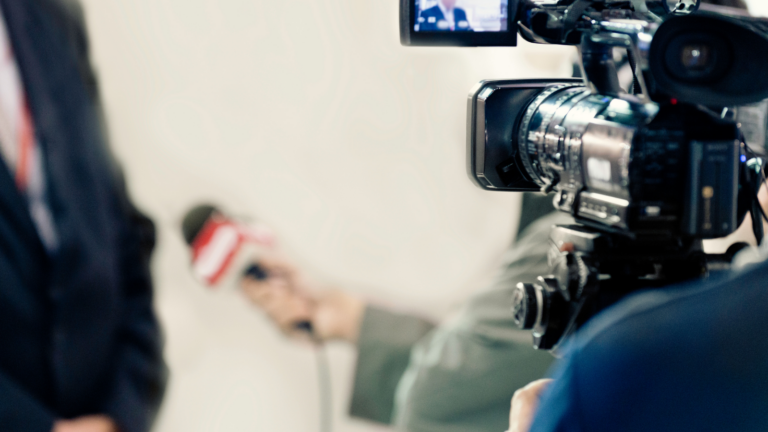Sharing your story with the world can feel pretty intimidating—especially if it’s your first time facing the public. If you’ve ever seen a spokesperson handle the press like a pro, chances are they had extensive media training before their first interview. If you’re nervous about speaking in public (77% of people are, after all), know that those jitters are normal and that there are plenty of tried-and-true techniques to help you ease into the glow of the spotlight.
With the information in this article, your spokespeople will be ready to handle any curveball a reporter might throw their way with confidence and ease.
What Is Media Training and Why Is It Essential?
Media training gives spokespeople a deep understanding of how reporters think and how the news cycle works. The training process involves a combination of practical hands-on prep, such as mock interviews, and detailed feedback sessions to help the spokesperson identify any interview skills they need to improve. In-depth media training helps interviewees approach the press comfortably, ready for any conversation that takes shape.
Beyond ensuring you’re comfortable and confident in your interview, media training is also one of the best tools for managing public perception and defusing crises before they spiral out of control. Well-trained spokespeople give quick, consistent responses that create a strong connection rooted in trust with their audience.
How to Prepare a Spokesperson for Media Interviews
Becoming a confident, media-trained spokesperson doesn’t happen overnight—putting that training into practice takes time and preparation.
Here are some helpful tips to make sure your spokespeople are ready to face any interview opportunity that comes their way:
Define Key Messages
One of the best ways to prepare a spokesperson for media interviews is to clearly define your key messages. These should reflect your organization’s values, goals, and current priorities while also speaking to what your audience cares about. The trick is to boil down complicated information into quippy, memorable statements so the audience can remember your message.
Keeping your key messages factual, relevant, and easy to remember will help reinforce your brand’s most important ideas while keeping all your media conversations on track.
Anticipate Media Questions
As you prepare to face the media, it pays to learn how to step into the mind of a journalist—anticipating what they’ll ask and how they might frame their story. Researching industry trends, competitor angles, and recent coverage on similar topics can give your spokesperson a good idea of the direction the interview might go. Earnestly engaging in this prep work will help you predict potentially challenging questions and help you craft a plan to steer the conversation back toward your key messages should it start to drift.
When anticipating potentially tricky questions, it’s important not to panic and to acknowledge the question directly before guiding your response toward the talking points that best reflect your organization’s interests. Striking this balance will show the journalist that you respect them while still giving you control over your brand’s narrative.
Conduct Mock Interviews
When you know what message you hope to send and can anticipate potential questions, the next step is to prepare for real-time media opportunities by conducting mock interviews. These practice interviews simulate the stress and off-the-cuff nature of live press interactions, helping you sharpen your public speaking skills while testing your ability to stay on message.
Many organizations invest in professional interview coaching to create high-pressure simulations like press conferences or breaking news settings to make mock interviews even more true to real life. We recommended recording these trial runs and watching the footage to spot any habits like using too many filler words or awkward body language. When you can catch these habits in practice simulations, you can correct them well before the camera goes live for your first real interview.
Coach on Delivery and Body Language
As you practice, pay attention to your delivery and body language—these are the key signals that help your audience understand and connect with your message. Whether they tune in to your tone of voice, posture, facial expressions, or ability to make eye contact, learning to have a strong, steady presence will make all the difference in how the public receives your interview.
Hiring a coach can help you correct your posture, learn the right pace to speak at, and teach you how to pause strategically for emphasis. This type of coaching will help you appear polished and composed in your live interviews, making you a more credible voice in your industry.
How to Prepare for Crisis Situations
Nobody signs up for a crisis, but when high-stakes moments hit, being prepared is your best defense strategy. In crises, every word a spokesperson says can be scrutinized and dissected by the public, so it’s vital to know exactly what can be shared and what should remain off the record.
When the pressure is on, spokespeople should stay calm and focused. Sticking to the facts, acknowledging concerns transparently, and avoiding speculation will help them keep their narrative in check during turbulent times.
Conducting regular drills and scenario-based rehearsals in your mock interviews can ensure your crisis communication plan isn’t just a document on a shelf but a living, breathing strategy your team knows how to execute. The more prepared you are for these situations, the better you will be at navigating PR crises with a level head.
Common Mistakes to Avoid in Media Training
As you improve at interviewing, it’s crucial to understand the common mistakes you should avoid throughout your training. One of the most common slip-ups is overloading a spokesperson with too much information. If someone juggles too many unfocused talking points, it’s easy to get confused or stray off-topic. This is why focusing on your key messages as often as possible is essential for your success.
Another pitfall comes from skipping out on the practice process. After nailing one mock interview, it can be tempting to believe you’ve mastered the art of the interview. Regardless, you should encourage your spokespeople to get in as much practice as possible to mitigate the natural nerves that come from live interviews. There’s a reason we have the old adage, “practice makes perfect” —the more you prepare, the more confident you will appear on camera.
Lastly, it’s noteworthy not to overlook the media platform where the interview is taking place. What reads well on live TV might fall flat in an online article, so you should research the publication and its demographics before your interview. Selecting key messages to align with different media outlets helps your brand’s overall message resonate no matter where your interview takes place.
Conclusion
We hope these strategies have been helpful and can turn invitations to interview into opportunities to shape your brand’s image. With these techniques in your toolkit, your spokesperson will be able to confidently step into the spotlight and be a brand representative that you feel proud of.
At Qwoted, we want to help you connect with top-tier journalists to get your story into the world. Sign up today to find opportunities to polish your pitching skills and get more features for your spokespeople.



